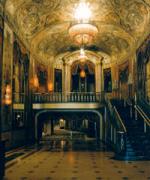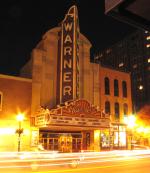![header=[Marker Text] body=[An early milestone for the Warners' film empire was the operation by Harry, Sam, and Albert Warner of a theater here, 1906-07. It seated 99 persons, who could view three movies for a nickel. Sixteen years later, Warner Bros. Pictures was established.] sign](http://explorepahistory.com/kora/files/1/10/1-A-261-139-ExplorePAHistory-a0h7z2-a_450.jpg)
Mouse over for marker text
Name:
Warner Brothers' First Theater
Region:
Pittsburgh Region
County:
Lawrence
Marker Location:
11-15 South Mill St., New Castle
Dedication Date:
November 16, 1994
Behind the Marker
So much about the movies changed the day  Edwin S. Porter unreeled The Great Train Robbery to a New York audience in late 1903. By opening the door to the possibilities of story-telling on film, Porter also helped open the door to a spellbinding new form of entertainment. Until the birth of the story movie, pioneer exhibitors like Wilkes Barre businessman
Edwin S. Porter unreeled The Great Train Robbery to a New York audience in late 1903. By opening the door to the possibilities of story-telling on film, Porter also helped open the door to a spellbinding new form of entertainment. Until the birth of the story movie, pioneer exhibitors like Wilkes Barre businessman Lyman Howe were essentially traveling salesmen. Moving from location to location, town to town, they set up their projectors and screens wherever they could rent space - in community halls, church basements, legitimate theaters, even under tents. But movie theaters? The idea didn't exist.
Lyman Howe were essentially traveling salesmen. Moving from location to location, town to town, they set up their projectors and screens wherever they could rent space - in community halls, church basements, legitimate theaters, even under tents. But movie theaters? The idea didn't exist.
And then, seemingly overnight, a new generation of theaters offering inexpensive entertainment began popping up from one corner of the nation to the next, in the largest cities and the smallest towns. There was nothing fancy about these theaters at first; the majority were nothing more than converted storefronts with a make-shift screen and some folding chairs. Their five-cent admission price made them particularly popular in working-class and immigrant neighborhoods; it also gave these theaters their name: nickelodeons.
Nickelodeons did more than just attract new audiences to the movies. They also lured a new breed of opportunity-seekers into a burgeoning business, among them a trio of brothers: Harry (1881-1958), Albert (1884-1967), and Sam (1888-1927) Warner.
Their parents, Polish immigrants, had settled in Youngstown, Ohio, just west of the Pennsylvania border, not long after the birth of their youngest son, Jack (1892-1978), in Canada, where their father tried a variety of trades. By the turn of the century, Harry and Albert had tried many businesses - from selling bicycles to soap - without much success. Meanwhile Sam, barely into his teens and employed by the railroad as a fireman, learned how to operate and repair an Edison projector that a friend had sitting in his machine shop. He left the railroad, moved to Chicago to work as a projectionist, then came back home when the local amusement park began running movies. But he soon realized there was more money to be made in running the show. As Jack recalled years later, "[Sam] saw the vast possibilities in this new form of entertainment, and he was ready to do anything short of robbing a bank to get his hands on a projector of his own."
Sam didn't have to rob a bank; he just had to convince his family to stake him to a used projector. The Warners sold the delivery horse of father Ben's butcher shop, ponied up the rest of their savings, and planted the seed that ultimately sprouted into one of Hollywood's most durable operations: Warner Bros.
Fortunately for Sam, his projector came with a print of The Great Train Robbery. He, Albert, and Harry began by putting up a tent in their yard to run the movie, then rented a storefront for a week in Niles, earning a remarkable $300, more than their father had ever earned in a month. Then they took the show on the road around Ohio and Pennsylvania. They did so well that when they returned to Youngstown, they tried setting up a storefront theater of their own but ran into opposition from the city; movies still carried the stigma of lower-class entertainment in most quarters. So the brothers went elsewhere.
New Castle, a steel town just across the Pennsylvania border with a growing immigrant population - the perfect demographics - had proven their most profitable tour stop. There, the brothers leased space in the Knox Building on South Mill Street, and for two years ran their modest 99-seat theater as the "Cascade," named for a local park. And it was modest. To fill the house, the brothers borrowed chairs from a nearby funeral parlor, a smart cost-cutting strategy but not without risk; when somebody died, they could not run the films.
It was also a true family operation. While Sam ran the projector, Harry rented movies from a neophyte film exchange in Pittsburgh, and Albert kept the books. Their sister Sadye sold tickets, and on weekends the two youngest Warners, Rose, a pianist, and Jack, who'd toured as a boy soprano in vaudeville, came in from Youngstown to entertain between shows.
Though the Cascade did quite well, Harry quickly realized that the pot of gold wasn't to be found in exhibiting films, but owning the prints and renting them to other exhibitors. So in 1907, the Warners sold the Cascade and left New Castle, moving to Pittsburgh where they established their own exchange, the Duquesne Amusement and Supply Company.
In time, the brothers began producing their own films, first in New York, then Hollywood, where the studio they founded still carries the Warner name. Its movies include The Jazz Singer, Little Caesar, Treasure of the Sierra Madre, To Have and Have Not, Yankee Doodle Dandy, Mildred Pierce, A Streetcar Named Desire, Bonnie and Clyde, The Exorcist, Dirty Harry, Blazing Saddles, Caddyshack, Superman, Driving Miss Daisy, the Looney Tunes and Merrie Melody cartoons, the Harry Potter and Batman series, The Matrix, Million Dollar Baby, and perhaps the most beloved film of all, Casablanca.
And then, seemingly overnight, a new generation of theaters offering inexpensive entertainment began popping up from one corner of the nation to the next, in the largest cities and the smallest towns. There was nothing fancy about these theaters at first; the majority were nothing more than converted storefronts with a make-shift screen and some folding chairs. Their five-cent admission price made them particularly popular in working-class and immigrant neighborhoods; it also gave these theaters their name: nickelodeons.
Nickelodeons did more than just attract new audiences to the movies. They also lured a new breed of opportunity-seekers into a burgeoning business, among them a trio of brothers: Harry (1881-1958), Albert (1884-1967), and Sam (1888-1927) Warner.
Their parents, Polish immigrants, had settled in Youngstown, Ohio, just west of the Pennsylvania border, not long after the birth of their youngest son, Jack (1892-1978), in Canada, where their father tried a variety of trades. By the turn of the century, Harry and Albert had tried many businesses - from selling bicycles to soap - without much success. Meanwhile Sam, barely into his teens and employed by the railroad as a fireman, learned how to operate and repair an Edison projector that a friend had sitting in his machine shop. He left the railroad, moved to Chicago to work as a projectionist, then came back home when the local amusement park began running movies. But he soon realized there was more money to be made in running the show. As Jack recalled years later, "[Sam] saw the vast possibilities in this new form of entertainment, and he was ready to do anything short of robbing a bank to get his hands on a projector of his own."
Sam didn't have to rob a bank; he just had to convince his family to stake him to a used projector. The Warners sold the delivery horse of father Ben's butcher shop, ponied up the rest of their savings, and planted the seed that ultimately sprouted into one of Hollywood's most durable operations: Warner Bros.
Fortunately for Sam, his projector came with a print of The Great Train Robbery. He, Albert, and Harry began by putting up a tent in their yard to run the movie, then rented a storefront for a week in Niles, earning a remarkable $300, more than their father had ever earned in a month. Then they took the show on the road around Ohio and Pennsylvania. They did so well that when they returned to Youngstown, they tried setting up a storefront theater of their own but ran into opposition from the city; movies still carried the stigma of lower-class entertainment in most quarters. So the brothers went elsewhere.
New Castle, a steel town just across the Pennsylvania border with a growing immigrant population - the perfect demographics - had proven their most profitable tour stop. There, the brothers leased space in the Knox Building on South Mill Street, and for two years ran their modest 99-seat theater as the "Cascade," named for a local park. And it was modest. To fill the house, the brothers borrowed chairs from a nearby funeral parlor, a smart cost-cutting strategy but not without risk; when somebody died, they could not run the films.
It was also a true family operation. While Sam ran the projector, Harry rented movies from a neophyte film exchange in Pittsburgh, and Albert kept the books. Their sister Sadye sold tickets, and on weekends the two youngest Warners, Rose, a pianist, and Jack, who'd toured as a boy soprano in vaudeville, came in from Youngstown to entertain between shows.
Though the Cascade did quite well, Harry quickly realized that the pot of gold wasn't to be found in exhibiting films, but owning the prints and renting them to other exhibitors. So in 1907, the Warners sold the Cascade and left New Castle, moving to Pittsburgh where they established their own exchange, the Duquesne Amusement and Supply Company.
In time, the brothers began producing their own films, first in New York, then Hollywood, where the studio they founded still carries the Warner name. Its movies include The Jazz Singer, Little Caesar, Treasure of the Sierra Madre, To Have and Have Not, Yankee Doodle Dandy, Mildred Pierce, A Streetcar Named Desire, Bonnie and Clyde, The Exorcist, Dirty Harry, Blazing Saddles, Caddyshack, Superman, Driving Miss Daisy, the Looney Tunes and Merrie Melody cartoons, the Harry Potter and Batman series, The Matrix, Million Dollar Baby, and perhaps the most beloved film of all, Casablanca.








